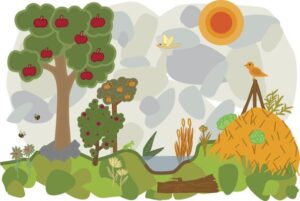Introduction

In today’s world, where environmental concerns and the quest for sustainability are more pressing than ever, I have discovered the transformative power of permaculture. It has become my personal journey towards creating regenerative systems that not only benefit the planet but also nurture my own well-being. Rooted in the principles of ecology, permaculture offers a holistic approach to sustainable living and land management, allowing me to design self-sufficient and resilient ecosystems that align with my values.
The term “permaculture” was introduced to me by Bill Mollison and David Holmgren in the 1970s. Combining “permanent” and “agriculture,” it encompasses a comprehensive philosophy, design system, and way of life. It goes beyond sustainable agriculture, incorporating elements like architecture, renewable energy, water management, and community development. This resonated with me deeply as I realized that true sustainability requires a harmonious integration of all aspects of our lives.
At the heart of permaculture lie three fundamental ethics: care for the Earth, care for people, and fair share. These principles have become my guiding light, shaping every decision I make in my permaculture journey. By prioritizing the well-being of the Earth and its inhabitants, I am not only contributing to long-term sustainability but also actively participating in the regeneration of natural systems.
Principles of Permaculture
Permaculture design is not a rigid set of rules but rather a set of twelve guiding principles that empower me to create sustainable and regenerative systems. These principles have become my roadmap, helping me navigate the complexities of design while staying true to the wisdom of nature. Here are some of the principles that have resonated with me deeply:
- Observe and interact: Before making any interventions, I take the time to keenly observe the natural patterns and processes in my environment. This allows me to design interventions that are perfectly attuned to the needs of the system.
- Catch and store energy: I have learned to utilize and capture energy from diverse sources such as the sun, wind, and water. This not only reduces waste but also minimizes my reliance on non-renewable resources.
- Obtain a yield: Creating systems that provide multiple outputs and benefits has been a rewarding experience for me. From growing my own food to generating renewable energy, I am able to reap the rewards of my efforts while promoting resilience and abundance.
- Use renewable resources and services: By consciously favoring renewable resources and ecological processes over non-renewable alternatives, I am reducing my ecological footprint and embracing a more sustainable way of life.
- Design from patterns to details: Understanding the natural patterns within a system has been a revelation for me. By working in harmony with these patterns, I have been able to create designs that are not only effective but also aesthetically pleasing.
- Integrate rather than segregate: Embracing the concept of integration has allowed me to foster beneficial relationships between different elements of my permaculture system. This interconnectedness promotes system health, diversity, and resilience.
- Use small-scale and slow solutions: I have come to appreciate the beauty of small-scale interventions. They are easier to manage, adapt, and have a greater chance of long-term success and sustainability.
- Optimize edge effects: I have discovered the immense potential that lies at the edges of different habitats within my permaculture system. By maximizing the benefits and opportunities presented by these interfaces, I have witnessed increased diversity, productivity, and harmony.
- Collaborate with nature: Working hand in hand with nature has been a humbling and enriching experience. I have learned to observe and mimic nature’s solutions, harnessing its resilience and regenerative capacities.
- Use and value diversity: Embracing diversity in all its forms has become an integral part of my permaculture journey. Recognizing the importance of biological, cultural, and social diversity has not only enhanced the resilience of my systems but also enriched my own life.
- Use edges and value the marginal: I have learned to see the potential that lies within the margins and boundaries of my permaculture system. These often-neglected spaces have become a source of innovation, productivity, and creativity.
- Creatively use and respond to change: Embracing change as an opportunity for growth and adaptation has been a valuable lesson. I design systems that are flexible, adaptable, and responsive to the evolving circumstances around me.
Permaculture has become a deeply personal and enriching journey for me. It has allowed me to cultivate a profound connection with nature, while actively contributing to the healing and regeneration of our planet. Through permaculture, I am creating a sustainable and harmonious life, one that aligns with my values and inspires me to build a regenerative future for generations to come.
For a deeper dive into each principle start with my article on permaculture principle number one here.
